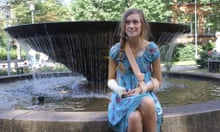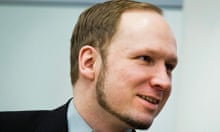Three survivors of Anders Behring Breivik's Utøya island massacre have described how they clung on to life in a room filled with death.
Seven teenagers were killed in the Little Hall of the island's cafe on 22 July last year. Ingvild Leren Stensrud survived only because another girl, Ronja Søttar Johansen, fell on top of her.
Stensrud had been shot twice in the knee and shoulder. As the life ebbed out of Johansen, Stensrud played dead underneath her, trying not to breathe.
"I was lying with my eyes closed, motionless. Then he hit me in the shoulder," she told Oslo's criminal court. There was silence and she thought he had gone – until she heard a terrible sound. "He was reloading."
Whether Breivik believed she was dead or whether he got distracted is unclear. But he finally left the room. Lying there, she heard cries outside which she thought belonged to Breivik's accomplices. "I thought I could hear war cries or battle cries or celebratory shouts," she said.
She couldn't make out the words and thought they were speaking a foreign language. It was only later she realised she was hearing the terrified screams of her friends trying to escape.
Also lying on the floor of that bloody room was a boy, now 18, who does not want to be identified. Breivik shot him in the foot. Right next to him was the body of his friend, Bendik Rosnæs Ellingsen. He was dying: Breivik had shot him eight times in the head and face. The witness said he had one overriding memory: "What I remember best was opening my eyes and feeling the rush of blood from Bendik."
He lay there quietly until help eventually arrived. "I lay there with all the people, the blood. It was like a pool of blood that I lay right in the middle of. Blood is warm in the beginning but it turns icy cold after a while, so I was really cold."
His mind was full: "I was thinking what consequences this would have to the nation, to us, to my life. You have a lot of philosophical thoughts in a situation like that."
He ran through in his mind images of the man who had shot him: "I noticed, though I didn't look at him too much, I noticed that he was white and dressed in black. So I quickly associated him with something rightwing extremist. That turned out later to be true. All traitors from before the war until today have been rightwing extremists."
At this point in proceedings, Breivik smiled. Until then, he had stared straight ahead, occasionally fiddling with his pen; never showing any emotion.
The 18-year-old remembered talking to Stensrud and them both trying to keep another boy awake, Glenn Martin Waldenstrøm, now 20.
The anonymous witness felt sure he was watching Waldenstrøm die.
"I was pretty certain that he would bleed to death before we could get any help. The way I remember it, he was bleeding so badly. We tried to keep contact with him but he could barely speak."
But Waldenstrøm survived to give evidence on Wednesday. It was immediately clear that he has yet to recover from the physical and mental injuries Breivik caused him that day. He has a scar in the middle of his neck, where a bullet entered, passing through the palate of his mouth and out just under one of his eyes.
His vision is severely impaired – one eye has just 10% vision left and the other struggles to compensate. But Waldenstrøm did not want to face Breivik in the courtroom. His lawyer made an application for Breivik to watch proceedings from a side room. He agreed.
When Waldenstrøm woke up from a coma two days after the attacks, his first thoughts were of guilt. "The first thing I said was I apologised for not saving Silje," he said, referring to his friend Silje Merete Fjellbu, whom he tried and failed to protect from Breivik's bullets.
He remembered the strange expression on Breivik's face. "It was a mixture of joy and anger. His face was distorted in a way. His forehead looked angry but his mouth was smiling," he said.
On Tuesday, another survivor of the Little Room massacre was defiant in the face of the atrocity. "We are stronger than ever," Ina Rangønes Libak told the court.
On Monday, another girl who swam to safety said she triumphed over Breivik: "We won. He lost. Norwegian youth can swim."
And though Waldenstrøm still suffers the effects of the attack – "I have been terribly frightened sometimes," he said – he allowed himself to feel triumphant. He had read Breivik's witness statement, he told the court, and noted his account of the Little Room massacre. Breivik referred to seeing a boy bleeding heavily from the neck, dead or dying. "I felt that had to be me and I felt a great sense of victory," said Waldenstrøm. "I felt, yes, I tricked him. I was able to fool him."


